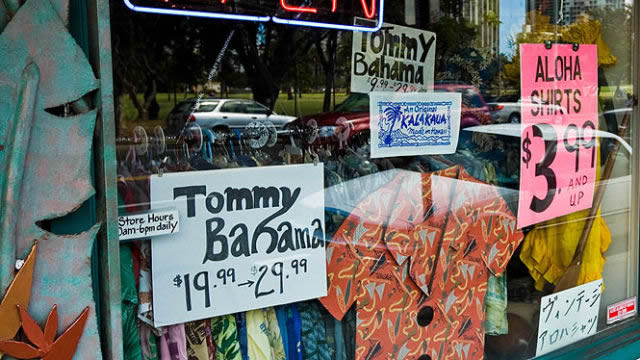As residents and visitors throughout the U.S. bear high temperatures, they apply creative and conventional ways to beat the heat. Staying hydrated, carrying handkerchiefs or tissues, applying sun block and participating in water sports and limiting time spent in the sun are a few methods to keep cool. Apparel is significant and it’s not always easy to find the right clothing.
Honolulu is a great place to shop and find your perfect aloha shirt. Stay nearby in one of our Kahala vacation rentals.
History
Appropriately, July 2011 is the unofficial 75th anniversary of the Aloha shirt, Hawaii’s visual marketing, via apparel. An article in USA Today Travel shares the history of the shirt, considered a longstanding and timeless expression that simply says, Hawaii, by anyone wearing it, including notable figures Bing Crosby, Tom Selleck and Elvis Presley. Most likely President Obama has a few in his closet.
The Hawaii Visitors and Convention Bureau notes the varied history of the shirt. The kapa cloth in the Pacific region, which is made by pounding tree bark and then dyeing it is one origination. The aloha shirt is also credited to the Filipino immigrants and the Japanese, a creation from their kimono cloth.
Other notable facts about the Aloha shirt—Honolulu tailor Ellery Chun trademarked the term in the 1930s and the Japanese government used the shirt as a strategy for energy conservation and encouraged workers to trade their professional slacks and shirts for this casual look. The Honolulu Chamber of Commerce commissioned a study to find apparel better suited to the island’s climate and even passed a resolution to allow open-necked sports shirts as accepted apparel from June through October. They later amended their resolution to include the Aloha shirt that had previously been excluded for the bold patterns. Eventually, Aloha Week was introduced as an annual feature and Hawaii’s icon and legend, Duke Kahanamoku embraced these shirts and furthered their popularity and acceptance as a beloved island image.
Gradually, Aloha shirts were being discovered by visitors with the loud prints and colorful appeal and reflecting the essence of the laid-back lifestyle visitors yearn for, even temporarily. Many organizations and individuals continued to show their support for the Aloha shirts. The Hawaiian Fashion Guild presented shirts to all male legislators in the State House and their “Operation Liberation” prompted the Senate to pass a resolution encouraging Hawaiians to wear the shirts for Lei Day, May 1, and through summertime. Perhaps Americans can appreciate and credit their fellow countrymen for casual Fridays as Aloha Friday was introduced in 1966. In any case, the Aloha shirt is worn not just for casual occasions but elegant too, an incredible history after 75 years in a world where fashion is fickle but classics get better and continue to evolve.

